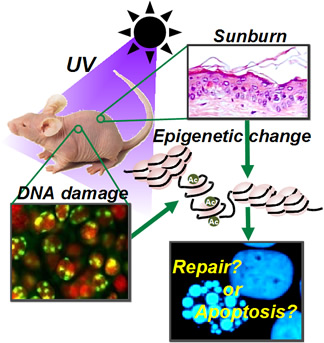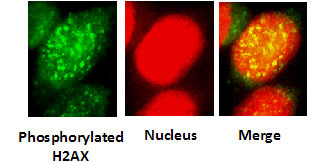Radiation Biology

- account_circleYuko IbukiPhD, Prof.
- account_circleYukako KomakiPhD, Research Asst. Prof.
- Website:https://sweb.u-shizuoka-ken.ac.jp/~photobio/
- Mail:ibuki@u-shizuoka-ken.ac.jp
- Phone:+81-54-264-5799
Study on DNA damage and repair: toward prevention of aging and cancer
Histone modification caused by environmental factors and alteration of DNA damage repair
Our goals and objectives are to elucidate the patterns of histone modification by multiple environmental factors and responses to DNA damage, and ultimately to protect humans from aging and cancer wherein histone modification is implicated.
- 1. Investigation of the relationship between environmental factor-modulated histone modification and DNA damage repair
Humans are exposed to multiple environmental factors such as chemicals and UV radiation. Histone modification caused by environmental factors alters the structure of chromatin. We hypothesize that the structural change of chromatin influences the ability to repair DNA damage.
establish new evaluation methods to assess their effects on human health.
- 2. Development of new methods to evaluate risks to human health using histone modification
Changes in histone modification regulate DNA repair and gene expression related to aging and certain diseases including cancer. We aim to establish new methods to evaluate risks of aging and cancer using histone modification as a marker.
- 3. Investigation of the mechanism of photoaging
We are studying the relationship between long wavelength UVA1 and aging, focusing on histone modification.
- 4.Mammalian toxicity of disinfection byproducts
Disinfection byproducts (DBPs) form as a result of undesirable side reaction of drinking water disinfection process. We are investigating the toxicity mechanism of DBPs, including histone modification, DNA damage induction and repair, and the alteration of cell cycle progression.
- Figure 1
- Histone modification alters the ability to repair UV-induced DNA damage

- Figure 2
- Histone modification by concomitant exposure to chemicals and UV.

References
- Mutat. Res. 858-860, 503273 (2020)
- Toxicol. In Vitro 61, 104687 (2019)
- Chem. Res. Toxicol. 31, 145-155 (2018
- Carcinogenesis 39, 56-65 (2018)
- Mutagenesis 32, 215-232 (2017)